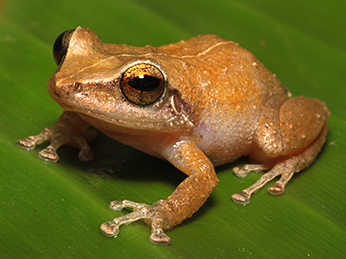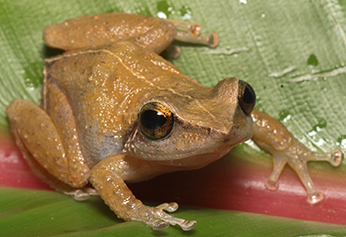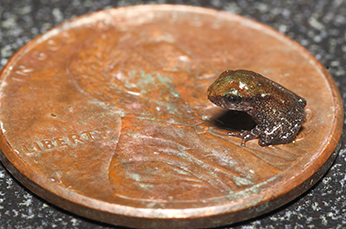(Eleutherodactylus coqui)
General Description


 Common coquis collected from a nursery in San Diego County in 2013. Top and middle, adult coqui on a tropical plant leaf. Bottom, juvenile (froglet) sitting on a penny. Photos courtesy of Chris Brown, US Geological Survey.
Common coquis collected from a nursery in San Diego County in 2013. Top and middle, adult coqui on a tropical plant leaf. Bottom, juvenile (froglet) sitting on a penny. Photos courtesy of Chris Brown, US Geological Survey.
Common coquis are small tree frogs that average 1 to 2 inches in length, with females being slightly larger than males. They have white to yellow coloration on their bellies, speckled with brown, and are brown to gray on their backs. Coquis have highly variable patterning on their backs ranging from no pattern to 1 or 2 broad cream stripes, v-shaped marks, spots, blotches, or a faint “M” between their shoulders. Eye color of the common coqui ranges from gold to brown. Coquis have large toes for climbing and lack webbing on their feet. Coquis are named after the call of the male, which is a loud, whistling “ko-KEE” sound. Unlike most frogs, coquis lay their eggs on the leaves of terrestrial trees and plants rather than in water. The young hatch as developed frogs (froglets) and do not experience the free-swimming tadpole stage.
Current Distribution
A single coqui was collected from a private residence in Orange County in 2012 and was determined to have originated by “hitchhiking” on a tropical house plant. Subsequent inspections of the nursery from which the plant was purchased, in San Diego County, detected (heard) multiple calling males and resulted in the collection of one adult, two froglets, and a cluster of coqui eggs. Currently, that population appears to be confined to the single nursery site. However, in 2014, after a month of nightly calling, what homeowners in Ocean Beach (San Diego) thought to be a songbird was determined to be a coqui. In the United States, coquis have established in southern Florida and Hawaii, as well as the Dominican Republic and the U.S. Virgin Islands.
Habitat Preference
Common coquis occupy a wide variety of habitats and elevations in their native range of Puerto Rico. In Hawaii, they have been found from sea level to 3800 meters. During the day they inhabit leaf litter and ground vegetation and then move into trees during the night. In Florida, coquis are usually found near greenhouses in secluded habitats that are close to the ground such as rock piles, the leaves of palms and other tropical vegetation, tree cavities, and under rocks and logs.
Pathways
Common coquis were most likely introduced into the United States and other countries via the tropical plant nursery trade, although some introductions into Hawaii were intentional. The most likely pathway of coqui introduction into California would be through tropical plant shipments from Hawaii, and it is not uncommon for the California Department of Agriculture to intercept shipments that contain coqui frog eggs. Coquis have also been introduced to new areas via the pet trade. However, the common coqui has been placed on California’s restricted animal list, which prohibits its importation, transportation, or possession without a permit.
Impacts
Common coquis have reached densities of over 22,500 frogs per acre in Hawaii. The nocturnal call of a male coqui can reach noise levels of 80 to 90 decibels, the equivalent of a running lawnmower. In Hawaii, the noise produced by coquis has led to a loss of sleep by local residents, complaints from tourists, and lower property values for infested areas. Coquis prey upon insects, spiders, crustaceans, and even smaller frogs; their high density populations can impact invaded ecosystems by out-competing native birds and other insect-eating animals for food. The abundance of coquis in some areas may lead to decreases in the populations of some native insect and spider species, some of which are already in decline or threatened with extinction. Additionally, coquis may impact the nursery trade, as their continued presence in tropical plant shipments may lead to tighter restrictions on the importation of such plants into California and other areas.
Actions Taken if Found
If you observe this species in California, please report your sighting to the CDFW Invasive Species Program, by email to Invasives@wildlife.ca.gov, or by calling (866) 440-9530.